There are over 40 different species of snakes in Kansas, which means there’s a good chance you might encounter one if you like spending time outside. The most common snakes are nonvenomous, like the northern water snake, the eastern racer, and the plains milk snake. However, there are six snakes that are venomous and dangerous, including cottonmouth snakes, copperhead snakes, and rattlesnakes. Let’s take a closer look at the four types of rattlesnakes in Kansas.
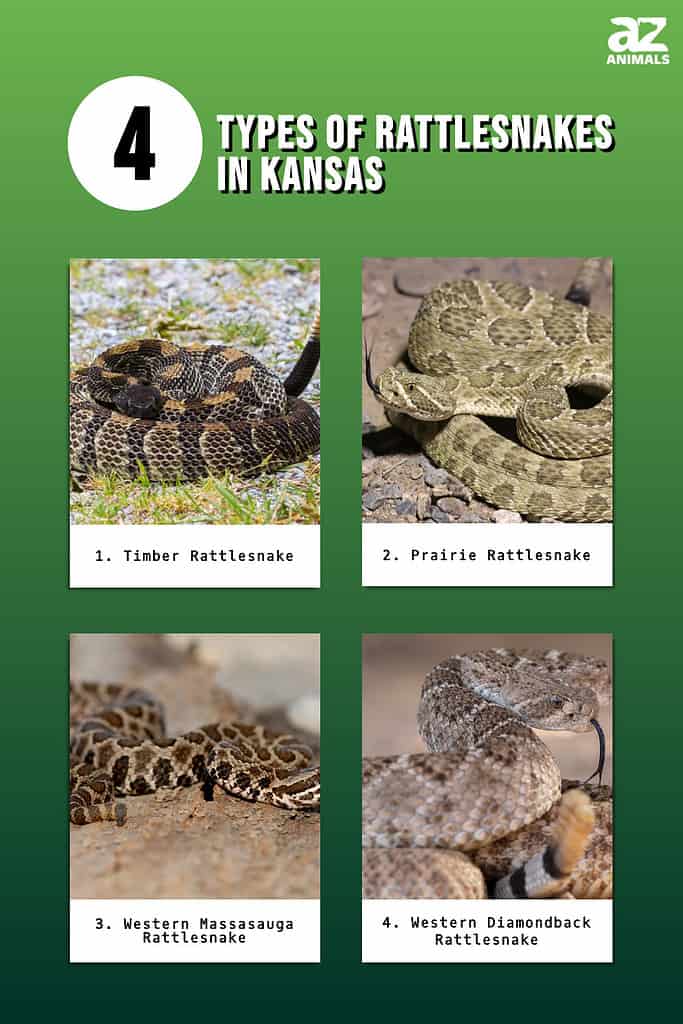
1. Timber Rattlesnake
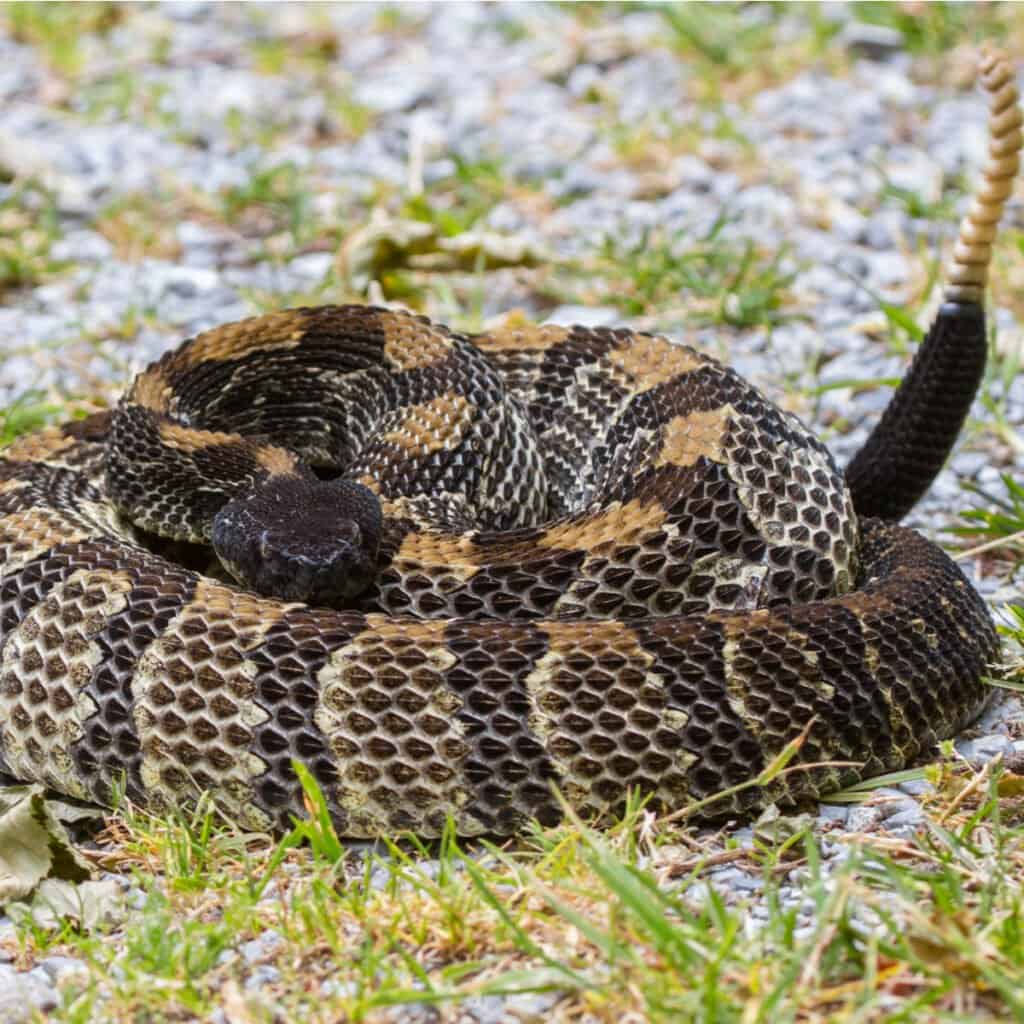
Timber rattlesnakes are surprisingly docile, shy, and secretive, hiding from humans as much as possible.
©Frode Jacobsen/Shutterstock.com
| Timber Rattlesnake | |
|---|---|
| Range | Eastern third of Kansas |
| Length | 36-60 inches |
The timber rattlesnake lives in a wide variety of habitats in the eastern third of Kansas. However, they are listed as a “Species in Need of Conservation” in Kansas, so it is illegal to kill timber rattlesnakes or destroy their dens here. Timber rattlesnakes prefer warmer weather, between 80-90 degrees Fahrenheit, and are active between April and October. When the temperature is too hot in the summer, they will often hide during the day and hunt at night.
These snakes are one of the most dangerous snakes in North America with very long fangs and lots of toxic venom, so it is best to stay as far from them as possible. However, timber rattlesnakes are not aggressive. In fact, these snakes are surprisingly docile, shy, and secretive, hiding from humans as much as possible. Even natives to Kansas do not see timber rattlesnakes often. If you leave a timber rattlesnake alone, it will return the favor. Most bites from timber rattlesnakes are due to a human harassing or mishandling the snake, or accidentally stepping on it.
Timber rattlesnakes are the largest native rattlesnake in Kansas, measuring 36-60 inches long (although western diamondbacks, which are rarely seen in the state, can grow larger). The largest timber rattlesnake reported in Kansas was found in Douglas County in 1899, measuring 63.5 inches in length. These snakes are typically grey, sometimes with pinkish hues. They have heavy bodies with jet-black tails, and black chevron markings running along their backs and sides. Some snakes also have a black, brown, orange, or pink stripe in the middle of their backs as well. Occasionally a timber rattlesnake will have extremely dark markings that it appear almost entirely black.
2. Prairie Rattlesnake
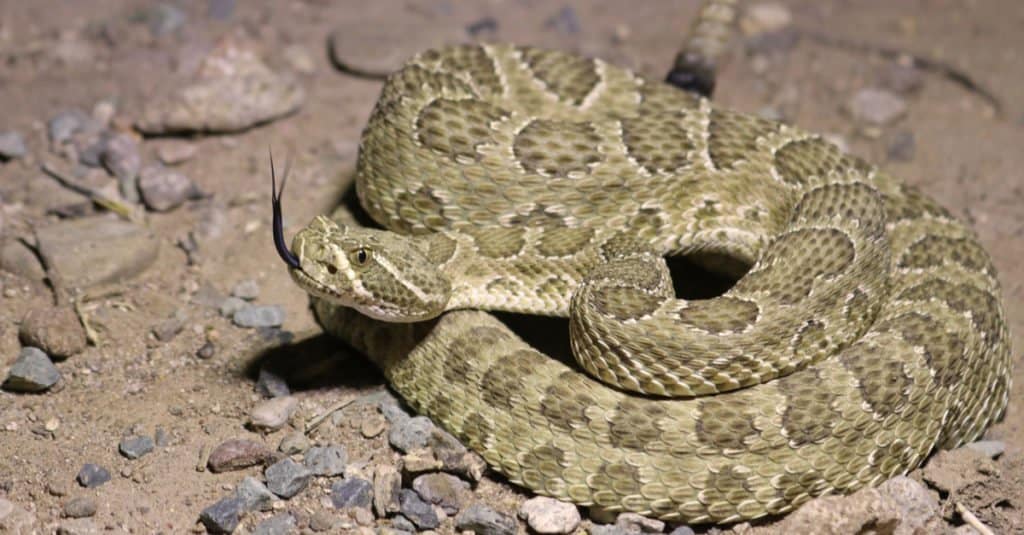
Prairie rattlesnakes are known to hide in rock crevices or small caves.
©Creeping Things/Shutterstock.com
| Prairie Rattlesnake | |
|---|---|
| Range | Western half of Kansas |
| Length | 36-60 inches |
The prairie rattlesnake lives in the western half of Kansas, often in rocky canyons, open prairies, or near mammal burrows. These snakes typically prefer hunting on the ground, although occasionally they may climb into smaller bushes, shrubs, and trees. Prairie rattlesnakes have neurotoxins and hemotoxins in their venom, and commonly eat pocket gophers, mice, rats, and lizards.
Like their name, prairie rattlesnakes have colors, patterns, and textures that help them to blend into prairie-like environments. Their bodies are typically tan, light brown, or greenish-grey, with various brown blotches running along their backs and dark bands on their tails. The scales along their long bodies are keeled, which means that there is a rough ridge in the middle of each scale. This gives the snake’s body a thick, coarse texture.
Prairie rattlesnakes have large triangular-shaped heads with two sets of stripes along either side of the face. The first stripe runs in a diagonal line from the back of each eye to the jaw. The second stripe begins below each eye and runs diagonally to the corner of the snake’s mouth. Prairie rattlesnakes are 3-5 feet in length. The largest prairie rattlesnake reported in Kansas was found in Hamilton County in 2004 and measured 57 1/8 inches in length.
3. Western Massasauga Rattlesnake
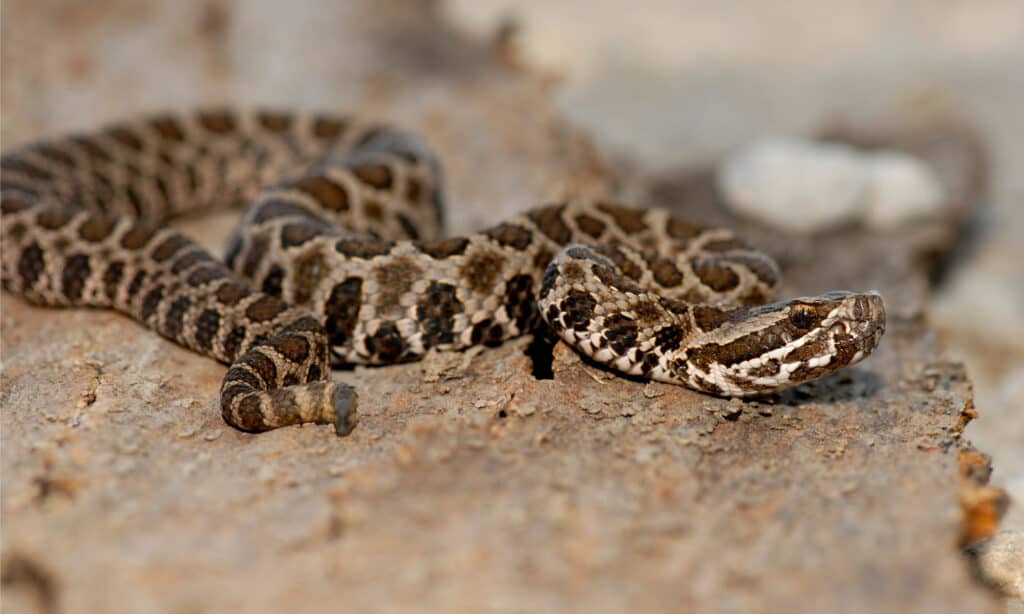
Young and juvenile western massasauga rattlesnake look like miniature versions of adult snakes.
©iStock.com/Shoemcfly
| Western Massasauga Rattlesnake | |
|---|---|
| Range | Eastern 2/3 of Kansas |
| Length | 18-30 inches |
The Western Massasauga Rattlesnake lives in the eastern 2/3 of Kansas, as well as some of the western regions along the Cimmaron and Arkansas Rivers. This snake is the smallest rattlesnake in Kansas, measuring between 18 and 30 inches in length. The largest massasauga rattlesnake reported in Kansas was found in Coffey County in 1984, measuring 33.5 inches long. Due to their small size, massasauga rattlesnakes have very small rattles that make a high-pitched buzzing sound. In some areas, these snakes have earned the nickname of “Buzztail” due to the unique quality of their rattling.
Western massasauga rattlesnakes are a subspecies of the massasauga rattlesnake. They are lighter in color than the desert massasauga and have light grey or tan bodies covered in dark brown blotches. The spots and blotches along the length of the snake’s body usually have a thin black outline as well. The snake has small dark bands on the end of its tail. The western massasauga has a dark stripe on either side of its face, running along its cheek from each eye to the jaw. Along the top of its head there are also two stripes running down to its neck.
Bites from a western massasauga rattlesnake can destroy tissue due to its cytotoxic venom. However, this snake is not very aggressive and rarely bites humans. Most bites from a western massasauga rattlesnake in Kansas occurred when the snake was stepped on, harassed, or mishandled.
4. Western Diamondback Rattlesnake
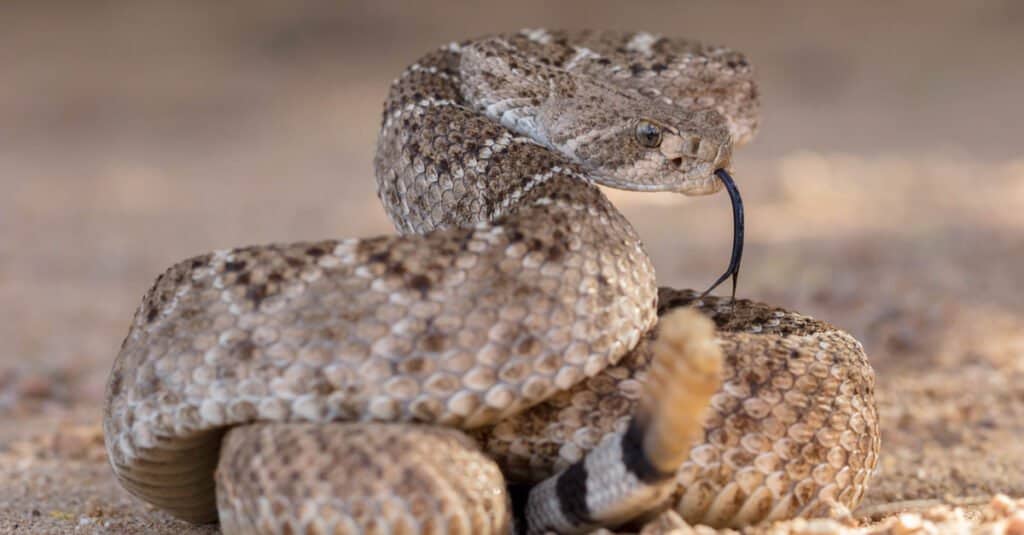
Western diamondback rattlesnakes coil up and rattle their tails to discourage predators.
©Alexander Wong/Shutterstock.com
| Western Diamondback Rattlesnake | |
|---|---|
| Range | Barber and Comanche counties; possibly near Kanopolis Reservoir |
| Length | 48-84 inches |
The western diamondback rattlesnake is extremely rare in Kansas, although there have been reports of it in Barber and Comanche counties in the extreme south-central regions of the state. There may also be a small population near Kanopolis Reservoir. These snakes prefer dry desert areas, as well as rocky regions, forests, and plains. The western diamondback rattlesnake is the largest rattlesnake in the southwestern desert, measuring 4-7 feet in length.
Western diamondback rattlesnakes are aggressive compared to the other rattlesnakes in Kansas. These snakes are more likely to take a stand and defend themselves rather than hide or flee. Western diamondback rattlesnakes are typically tan, yellow-grey, pale blue-grey, grey, grey-brown, salmon, olive, or cream-colored. Like their name, western diamondback rattlesnakes have dark, distinct diamond-shaped patterns running along the length of their bodies. Their diamond markings often have dark and cream-colored outlines.
The tail of a western diamondback rattlesnake is very distinct, with 2-8 black bands separated by cream, white, or pale grey. The snake’s head is large and broad, with a dark line running from the snake’s mouth to each eye. The scales along the snake’s body are extremely keeled and give the snake a tough and bristly appearance.
Summary of 4 Types of Rattlesnakes in Kansas
Here’s a recap of four types of rattlesnake species found in the state of Kansas.
| Number | Rattlesnake | Range | Length |
|---|---|---|---|
| 1 | Timber Rattlesnake | Eastern third of Kansas | 36-60 inches |
| 2 | Prairie Rattlesnake | Western half of Kansas | 36-60 inches |
| 3 | Western Massasauga Rattlesnake | Eastern 2/3 of Kansas | 18-30 inches |
| 4 | Western Diamondback Rattlesnake | Barber and Comanche counties; possibly near Kanopolis Reservoir | 48-84 inches |
The photo featured at the top of this post is © Harris Motion Photo/Shutterstock.com
Discover the "Monster" Snake 5X Bigger than an Anaconda
Every day A-Z Animals sends out some of the most incredible facts in the world from our free newsletter. Want to discover the 10 most beautiful snakes in the world, a "snake island" where you're never more than 3 feet from danger, or a "monster" snake 5X larger than an anaconda? Then sign up right now and you'll start receiving our daily newsletter absolutely free.
Thank you for reading! Have some feedback for us? Contact the AZ Animals editorial team.






